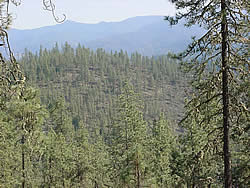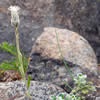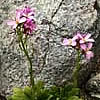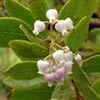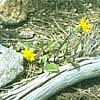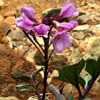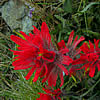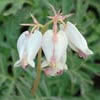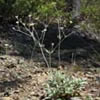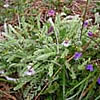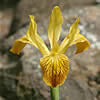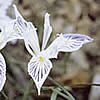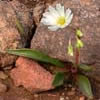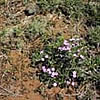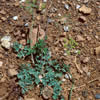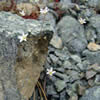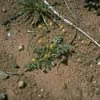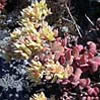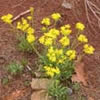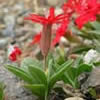USDA Forest Service Celebrating Wildflowers
|
|
|
Jeffrey Pine SavannaNames like Pine Flat Mountain and High Plateau of the western Klamath Mountains characterize the relatively level surface that underlies what is commonly termed Jeffrey pine savanna community. These flattened or broad ridge tops are associated with a remnant erosional surface called the Klamath peneplain. The peneplain is the result of the erosion of the Klamath Mountains in the Tertiary Period (5-35 million years ago) with subsequent uplift events that maintained the level surface (Alexander et. al. 2007). Peridotite and serpentinized peridotite comprise the primary parent material of these plateau surfaces. Shallow, loamy soils derived from serpentinized peridotite support the Jeffrey pine savanna community giving way to deeper, peridotite slopes of Jeffrey pine shrublands (Dubendorfer 1987). Jeffrey pine savannas occur between about 1,200 and 3,000 feet, and are subject to the maritime influence of the Pacific Ocean. Dominated by Jeffrey pine and grass, the savanna community exists as a vegetative mosaic likely due to localized differences in the degree of peridotite serpentinization, which would yield different soil characteristics (Dubendorfer 1987). Nested within the grassland are patches of upright shrubs such as huckleberry oak and tanbark oak, barrens, and Douglas-fir with a shrub-form of California bay. The mosaic pattern is also influenced by fire (Dubendorfer 1987), the primary disturbance agent in these communities. The importance of fire as a disturbance agent in maintaining the Jeffrey pine savanna community is uncertain given the low productivity and limited woody fuels that carry and hold a fire. Historically, fires were expected to be frequent and of low to moderate intensity (Skinner et al. 2006) moving quickly through the grass dominated areas and burning more intensely in shrub/conifer dominated areas Gnarled and stunted Jeffrey pine is the dominant species in the overstory layer of this community where canopy cover varies from less than 5% to upwards of 20%. Although stunted, these open stands of Jeffrey pine can support trees upwards to 400 years in age. Associate tree species include incense cedar and Douglas-fir. The floor of the community appears as a pebble and rock garden with tufts of Idaho fescue and scattered herbs, with trailing shrubs such as pine-mat manzanita, Siskiyou mat, and common juniper. In the Jeffrey pine savanna, one will encounter the greatest occurrence of serpentine endemics and rare species including opposite-leaved Lewisia, Waldo buckwheat, short-lobed Indian paintbrush, silky horkelia, and Peck's sanicle. Photo Gallery
Our thanks to CalPhotos and its many contributors for many of the pictures in this photo gallery. Resources and References
|
|
| NOTE: PDF format links require the Adobe Acrobat Reader to view. | |
| top | Disclaimers | FOIA | Privacy Policy | Quality of Information | Photo Credits & Use |
Location: http://www.fs.fed.us/wildflowers/communities/serpentines/communities/jeffreypine_savanna.shtml
Last modified: Wednesday, 03-Dec-2008 13:54:23 EST
